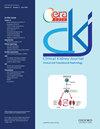视网膜血管几何参数与病理诊断的 2 型糖尿病肾病之间的相关性
IF 3.9
2区 医学
Q1 UROLOGY & NEPHROLOGY
引用次数: 0
摘要
背景 糖尿病肾病(DN)和糖尿病视网膜病变(DR)是糖尿病常见的微血管并发症。本研究旨在探讨视网膜血管几何参数与病理诊断的 2 型糖尿病肾病之间的相关性,并确定视网膜血管几何参数在区分糖尿病肾病和非糖尿病肾病(NDRD)方面的能力。方法 研究对象为接受肾活检的 2 型糖尿病(T2DM)和慢性肾病(CKD)成年患者。进行单变量和多变量回归分析,以评估视网膜血管几何参数与病理诊断的 DN 之间的关联。进行多变量二元逻辑回归分析以建立 DN 的鉴别诊断模型。结果 这项横断面研究共检查了 403 名患者,其中包括 152 名(37.7%)DN 患者、157 名(39.0%)NDRD 患者和 94 名(23.3%)DN 合并 NDRD 患者。经过单变量逻辑回归,发现总血管断裂维度、动脉断裂维度和静脉断裂维度均与 DN 相关。在调整了年龄、性别、血压、糖尿病、DR 和其他因素的多变量分析中,较小的视网膜血管断裂维度与 DN 显著相关(P &p;lt;.05)。我们建立了一个结合传统临床指标和视网膜血管几何参数的 DN 鉴别诊断模型,多变量逻辑回归建立的方程模型的曲线下面积为 0.930。结论 视网膜血管断裂维度对于快速、无创地鉴别 DN 具有重要意义。将视网膜血管断裂维度纳入 DN 和 NDRD 诊断模型可提高诊断效率。本文章由计算机程序翻译,如有差异,请以英文原文为准。
Correlation between retinal vascular geometric parameters and pathologically diagnosed type 2 diabetic nephropathy
Background Diabetic nephropathy (DN) and diabetic retinopathy (DR) are common microvascular complications of diabetes. The purpose of this study was to investigate the correlation between retinal vascular geometric parameters and pathologically diagnosed type 2 DN, and to determine the capacity of retinal vascular geometric parameters in differentiating DN from non-diabetic nephropathy (NDRD). Methods The study participants were adult patients with type 2 diabetes mellitus (T2DM) and chronic kidney disease (CKD) who underwent a renal biopsy. Univariate and multivariable regression analyses were performed to evaluate associations between retinal vessel geometry parameters and pathologically diagnosed DN. Multivariate binary logistic regression analyses were performed to establish a differential diagnostic model for DN. Results In total, 403 patients were examined in this cross-sectional study, including 152 (37.7%) with DN, 157 (39.0%) with NDRD, and 94 (23.3%) with DN combined with NDRD. After univariate logistic regression, Total vessel fractal dimension, arteriolar fractal dimension, venular fractal dimension were all found to be associated with DN. In multivariate analyses adjusting for age, sex, blood pressure, diabetes, DR, and other factors, smaller retinal vascular fractal dimensions were significantly associated with DN (P < .05). We developed a differential diagnostic model for DN combining traditional clinical indicators and retinal vascular geometric parameters, the area under the curve of the model for equation established by multivariate logistic regression was 0.930. Conclusions Retinal vessel fractal dimension is of great significance for the rapid and noninvasive differentiation of DN. Incorporating retinal vessel fractal dimension into the diagnostic model for DN and NDRD can improve the diagnostic efficiency.
求助全文
通过发布文献求助,成功后即可免费获取论文全文。
去求助
来源期刊

Clinical Kidney Journal
Medicine-Transplantation
CiteScore
6.70
自引率
10.90%
发文量
242
审稿时长
8 weeks
期刊介绍:
About the Journal
Clinical Kidney Journal: Clinical and Translational Nephrology (ckj), an official journal of the ERA-EDTA (European Renal Association-European Dialysis and Transplant Association), is a fully open access, online only journal publishing bimonthly. The journal is an essential educational and training resource integrating clinical, translational and educational research into clinical practice. ckj aims to contribute to a translational research culture among nephrologists and kidney pathologists that helps close the gap between basic researchers and practicing clinicians and promote sorely needed innovation in the Nephrology field. All research articles in this journal have undergone peer review.
 求助内容:
求助内容: 应助结果提醒方式:
应助结果提醒方式:


